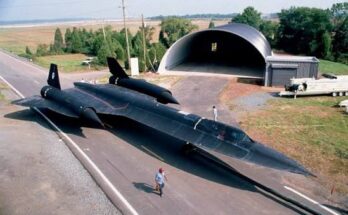
Tragic Crash: Vought F7U-3 Cutlass Accident Aboard USS Hancock Claims Pilot’s Life
Naval aviation has always been a field of immense skill and danger, requiring pilots to operate in some of the most challenging conditions. One such tragic event occurred when a Vought F7U-3 Cutlass, numbered 129595, crashed while attempting to land on the USS Hancock. The crash resulted in the death of the pilot, marking another somber chapter in the history of carrier-based aviation.
The Vought F7U-3 Cutlass: A Controversial Aircraft
The Vought F7U Cutlass was a revolutionary design ahead of its time. Developed in the late 1940s and early 1950s, the aircraft was one of the first carrier-based jet fighters for the U.S. Navy. It featured a tailless, swept-wing design that was unlike anything seen before. The Cutlass was intended to provide exceptional speed, maneuverability, and firepower.
However, the aircraft was plagued with technical problems from the start. Its unusual design resulted in stability issues, and the plane was notoriously difficult to land on aircraft carriers. Many pilots referred to it as one of the most dangerous planes in the Navy’s fleet, with a high accident rate that claimed the lives of multiple aviators.
The Fateful Landing Attempt on the USS Hancock
On the day of the accident, the pilot of F7U-3 Cutlass 129595 was returning to the USS Hancock, a U.S. Navy aircraft carrier operating at sea. Carrier landings are among the most difficult maneuvers in aviation, requiring precise control and coordination. Pilots must align their approach perfectly, adjusting speed and altitude while aiming for the small landing area on a moving ship.
As the Cutlass approached the deck, something went terribly wrong. Eyewitness accounts suggest that the aircraft may have been coming in too fast or at the wrong angle. Some speculate that mechanical failure could have played a role, as the F7U-3 was known for unreliable landing gear and sluggish response controls.
The aircraft failed to make a successful landing and instead crashed violently onto the deck of the USS Hancock. The impact was catastrophic, and despite immediate efforts by the crew, the pilot did not survive.
Reaction and Investigation
The loss of the pilot sent shockwaves through the naval aviation community. While every carrier landing is risky, crashes of this magnitude were always a grim reminder of the dangers pilots faced daily.

Naval officials launched an immediate investigation into the accident. While exact details of their findings were not fully disclosed, several potential factors were considered:
1. Mechanical Failure: The F7U-3 Cutlass had a reputation for unreliable performance. Issues with its engines, hydraulics, or landing gear may have contributed to the crash.
2. Pilot Error: Despite extensive training, even the most skilled pilots can make miscalculations, particularly when dealing with an aircraft as difficult to control as the Cutlass.
3. Carrier Conditions: Landing on an aircraft carrier is affected by weather conditions, sea movement, and deck readiness. Any of these factors could have played a role in the incident.
The Dangers of Carrier-Based Aviation
Operating jet aircraft from aircraft carriers is one of the most hazardous jobs in the military. The short runway space, the necessity of catching an arresting wire, and the unpredictable motion of the ship make each landing a life-or-death situation.
The F7U Cutlass was especially notorious among naval aviators. Throughout its service, the aircraft was involved in numerous accidents, earning a reputation as an unsafe design. Many pilots felt that its performance did not justify the risks associated with flying it.
The Legacy of the USS Hancock and the F7U Cutlass

The USS Hancock was a key aircraft carrier in the U.S. Navy, serving from World War II through the Vietnam War. The vessel was involved in numerous naval operations and was home to many brave pilots and sailors. The loss of the F7U-3 Cutlass and its pilot was a tragic reminder of the sacrifices made by those who served aboard.
As for the Vought F7U-3 Cutlass, the aircraft was eventually retired in the late 1950s. Its design flaws and high accident rate led the Navy to move on to more reliable aircraft. Today, it remains a cautionary tale in aviation history—a symbol of both innovation and the risks of pushing technology too far, too fast.
Remembering the Pilot and Honoring Naval Aviators
The pilot who lost his life in the crash aboard the USS Hancock was one of many brave men who risked everything in service to their country. Carrier-based aviation is not just about flying—it is about discipline, skill, and courage in the face of constant danger.
This incident serves as a solemn reminder of the challenges and sacrifices made by naval aviators throughout history. While technology and training have greatly improved modern carrier operations, the risks remain, and the bravery of those who take to the skies in service of their country continues to be honored.
Conclusion
The crash of Vought F7U-3 Cutlass 129595 on the USS Hancock was a tragic event that underscored the dangers of naval aviation. It also highlighted the limitations of an aircraft that, despite its futuristic design, ultimately proved to be unreliable and hazardous.
As the Navy moved forward with more advanced and safer aircraft, the sacrifices of those who flew the Cutlass were not forgotten. Their experiences helped shape the evolution of naval aviation, ensuring that future generations of pilots would fly aircraft better suited for the challenges of carrier operations.



